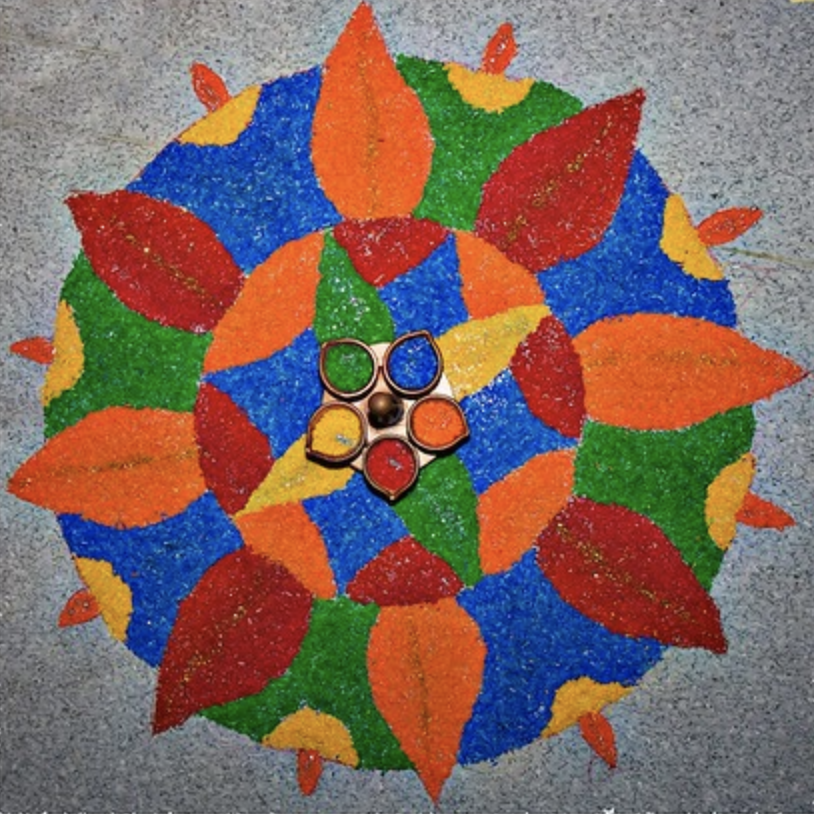[Most Recent Entries] [Calendar View]
Monday, May 20th, 2019
| Time | Event |
| 8:00a | Discover Kōlams, the Traditional Indian Patterns That Combine Art, Mathematics & Magic Have accomplished abstract geometrical artists come out of any demographic in greater numbers than from the women of South Asia? Not when even the most demanding art-school curriculum can't hope to equal the rigor of the k?lam, a complex kind of line drawing practiced by women everywhere from India to Sri Lanka to Malaysia to Thailand. Using humble materials like chalk and rice flour on the ground in front of their homes, they interweave not just lines, shapes, and patterns but religious, philosophical, and magical motifs as well — and they create their k?lams anew each and every day.
"Feeding A Thousand Souls: K?lam" by Thacher Gallery at the University of San Francisco is licensed under CC BY-SA 2.0 "Taking a clump of rice flour in a bowl (or a coconut shell), the k?lam artist steps onto her freshly washed canvas: the ground at the entrance of her house, or any patch of floor marking an entrypoint," writes Atlas Obscura's Rohini Chaki. "Working swiftly, she takes pinches of rice flour and draws geometric patterns: curved lines, labyrinthine loops around red or white dots, hexagonal fractals, or floral patterns resembling the lotus, a symbol of the goddess of prosperity, Lakshmi, for whom the k?lam is drawn as a prayer in illustration."
Colorful Kolam - - Own work K?lams are thought to bring prosperity, but they also have other uses, such as feeding ants, birds, and other passing creatures. Chaki quotes University of San Francisco Theology and Religious Studies professor Vijaya Nagarajan as describing their fulfilling the Hindu "karmic obligation" to "feed a thousand souls." K?lams have also become an object of genuine interest for mathematicians and computer scientists due to their recursive nature: "They start out small, but can be built out by continuing to enlarge the same subpattern, creating a complex overall design," Chaki writes. "This has fascinated mathematicians, because the patterns elucidate fundamental mathematical principles."
"Kolam" by resakse is licensed under CC BY-ND 2.0 Like any traditional art form, the k?lam doesn't have quite as many practitioners as it used to, much less practitioners who can meet the standard of mastery of completing an entire work without once standing up or even lifting their hand. But even so, the k?lam is hardly on the brink of dying out: you can see a few of their creators in action in the video at the top of the post, and the age of social media has offered k?lam creators of any age — and now even the occasional man — the kind of exposure that even the busiest front door could never match. Some who get into k?lams in the 21st century may want to create ones that show ever more complexity of geometry and depth of reference, but the best among them won't forget the meaning, according to Chaki, of the form's very name: beauty. Read more about k?lams at Atlas Obscura. Related Content: Mathematics Made Visible: The Extraordinary Mathematical Art of M.C. Escher New Iranian Video Game, Engare, Explores the Elegant Geometry of Islamic Art The Complex Geometry of Islamic Art & Design: A Short Introduction Based in Seoul, Colin Marshall writes and broadcasts on cities, language, and culture. His projects include the book The Stateless City: a Walk through 21st-Century Los Angeles and the video series The City in Cinema. Follow him on Twitter at @colinmarshall, on Facebook, or on Instagram. Discover K?lams, the Traditional Indian Patterns That Combine Art, Mathematics & Magic is a post from: Open Culture. Follow us on Facebook, Twitter, and Google Plus, or get our Daily Email. And don't miss our big collections of Free Online Courses, Free Online Movies, Free eBooks, Free Audio Books, Free Foreign Language Lessons, and MOOCs. |
| 11:00a | Keith Moon Plays Drums Onstage with Led Zeppelin in What Would Be His Last Live Performance (1977) When Led Zeppelin appeared in late 1968, they already had the makings of a supergroup, so to speak, though only founding member Jimmy Page was a famous rock star. Four equally talented and seasoned musicians, each integral to the band’s sound. But it might have been otherwise. Page first intended to create a literal supergroup, joining his fellow former Yardbird Jeff Beck and The Who’s Keith Moon and John Entwistle. Who knows what might have come of it? Moon supposedly quipped that it would go down like a lead balloon, inspiring the name of the band that was to come. This history makes all the more poignant the fact that Moon’s last onstage performance before his death was with Led Zeppelin. Moon joined the band during the L.A. stop of their 1977 tour to ramble drunkenly into the microphone and sit in on a drum and tambourine with John Bonham during a nearly 20-minute drum solo on “Moby Dick.” Moon also joined the band during the two-song encore of “Whole Lotta Love” and “Rock & Roll.” See parts of those performances at the top in audience footage. His brief moments behind John Bonham’s drums cannot be considered representative of what a hypothetical Keith Moon-backed Led Zeppelin might sound like. Not only was he playing another drummer’s kit—a significant handicap for Moon—but also, the Keith Moon of 1977 was not the Keith Moon of 1968. These documents of rock history can’t tell us what might have been, only, for a brief moment, what was. Moon has been regarded as one of the greatest drummers in rock for his huge musical personality. “No drummer in a true rock & roll band has ever been given—has ever seized, perhaps—so much space and presence,” wrote Greil Marcus in tribute when Moon died the year after his Led Zeppelin cameo. Moon, “as Jon Landau pointed out years ago… played the parts conventionally given over to the lead guitar.” Moon called himself, with typical sarcasm, “the best Keith Moon-type drummer,” an insight into just how singular his playing was. His total lack of restraint fit The Who perfectly. But history would decree that Bonham become the ideal Led Zeppelin-type drummer. He played lead parts as well, but never at the expense of rhythm. The pitfall of a supergroup—or a group of equally superb musicians—is that everyone can tend to overplay. Bonham was a superb musician, but also a drummer who knew exactly how to accommodate others’ virtuosity—building spacious rhythmic structures that held together the bombast of Plant and Page in a coherent whole. Bonham could follow Page’s riffs just as often as he could deploy his own thundering hooks. Keith Moon was at his best playing Keith Moon, sounding “as if he came out of nowhere to take over the world,” wrote Marcus. The Who’s “best singles and album tracks not only featured Moon, they were built around him,” Entwistle and Townshend providing structure while Moon supplied the fiery core. Hear him at his incandescent best in the isolated drum track for “Wont’ Get Fooled Again” above and read more about what made him so indelibly unique in Marcus’ eulogy for “the best drummer in the history of rock ‘n roll.” Listen to a full audience audio recording of that 1977 concert just below. via JamBase Related Content: Isolated Drum Tracks From Six of Rock’s Greatest: Bonham, Moon, Peart, Copeland, Grohl & Starr What Makes John Bonham Such a Good Drummer? A New Video Essay Breaks Down His Inimitable Style Josh Jones is a writer and musician based in Durham, NC. Follow him at @jdmagness. Keith Moon Plays Drums Onstage with Led Zeppelin in What Would Be His Last Live Performance (1977) is a post from: Open Culture. Follow us on Facebook, Twitter, and Google Plus, or get our Daily Email. And don't miss our big collections of Free Online Courses, Free Online Movies, Free eBooks, Free Audio Books, Free Foreign Language Lessons, and MOOCs. |
| 2:00p | Who Is Neil Young?: A Video Essay Explores the Two Sides of the Versatile Musician–Folk Icon and Father of Grunge Neil Young has worked with Rick James in the Mynah Birds and David Crosby, Steven Stills, and Graham Nash in CSNY. He’s recorded everything from tearjerking piano ballads to brilliantly meandering psych rock to folk, country, and early 80s electronic. He perfected the spontaneous sound of albums recorded live and loose in a barn, but he is meticulous about technology and sound quality. He’s a superstar and self-described “rich hippie” who has near-universal credibility with indie artists. He is both “a hippie icon but also the godfather of grunge,” says the Polyphonic video above. Young’s many seeming contradictions only strengthen his musical integrity. The shaggy Canadian singer, songwriter, guitarist, and leader of Buffalo Springfield and Crazy Horse has made films under the pseudonym “Bernard Shakey,” recorded soundtracks for acclaimed films, and inspired far more than the signature Seattle sound, though Pearl Jam and Nirvana both acknowledged their debt. The Velvet Underground may get much of the credit for the sonic qualities of indie and alternative rock, but Young deserves more than a little recognition for influencing not only Kurt Cobain but also the likes of Radiohead’s Thom Yorke, Sonic Youth’s Kim Gordon, and Pavement's Stephen Malkmus. It’s a hell of a rock and roll resume, to have achieved lasting, significant influence on modern folk, country, and indie rock, just to name the most obvious genres Young has touched, in a career showcasing some of the most emotionally honest music ever captured on record. Despite the shambling, seemingly out-of-control nature of much of his output, it’s a very carefully crafted showcase. The 1979 live album Rust Never Sleeps, for example, functions as both a summation of his musical output up to that point and a metacommentary on the many—or well, the two—sides of Neil Young. On one side, mellow, moody, solo acoustic folk, on the other, raucous, distorted rock and roll, courtesy of Crazy Horse. Bookending the record, the mirror image songs “My My, Hey Hey (Out of the Blue)” and “Hey Hey, My My (Into the Black),” tracks that apply the two different treatments to similar lyrics and arrangements, integrating the two sides of Young, which Polyphonic roughly divides into his acoustic Canadian pastoral side—warbling homesick ballads full of references to Ontario and other points north—and his American side: raw, edgy, full of righteous political indignation in songs like “Ohio, “Southern Man,” “Alabama,” and “Rockin’ in the Free World.” Those who love Neil Young need no further inducement to embrace his contradictions, even when his work is uneven. The tension between them keeps fans hanging on, knowing full well that his less successful efforts are paths on the way to yet more brilliant restatements of his major themes and minor chords. Those less familiar, or less appreciative, of Neil Young’s formidable legacy may find they’ve underestimated him after watching this whirlwind tour through his tireless crusade against musical complacency, war, racism, and environment destruction, and the rust that has crept over so many of his contemporaries. Related Content: When Neil Young & Rick James Created the 60’s Motown Band, The Mynah Birds Neil Young Performs Classic Songs in 1971 Concert: “Old Man,” “Heart of Gold” & More Neil Young’s Film “Le Noise” Debuts Online Josh Jones is a writer and musician based in Durham, NC. Follow him at @jdmagness Who Is Neil Young?: A Video Essay Explores the Two Sides of the Versatile Musician–Folk Icon and Father of Grunge is a post from: Open Culture. Follow us on Facebook, Twitter, and Google Plus, or get our Daily Email. And don't miss our big collections of Free Online Courses, Free Online Movies, Free eBooks, Free Audio Books, Free Foreign Language Lessons, and MOOCs. |
| << Previous Day |
2019/05/20 [Calendar] |
Next Day >> |











